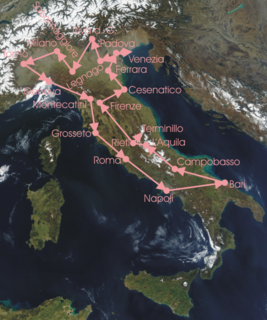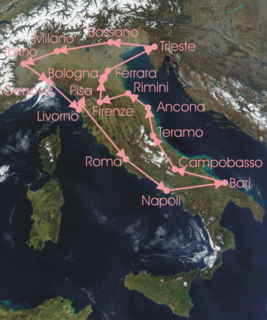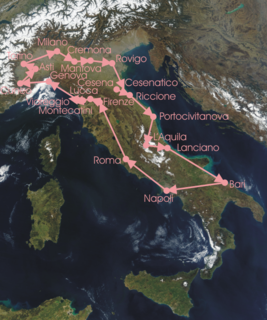Related Research Articles

The Giro d'Italia is an annual multiple-stage bicycle race primarily held in Italy, while also starting in, or passing through, other countries. The first race was organized in 1909 to increase sales of the newspaper La Gazzetta dello Sport; and is still run by a subsidiary of that paper's owner. The race has been held annually since its first edition in 1909, except during the two world wars. As the Giro gained prominence and popularity the race was lengthened, and the peloton expanded from primarily Italian participation to riders from all over the world. The Giro is a UCI World Tour event, which means that the teams that compete in the race are mostly UCI WorldTeams, with some additional teams invited as 'wild cards'.
The 1984 Giro d'Italia was the 67th running of the Giro d'Italia, one of cycling's Grand Tours races. The Giro started in Lucca, on 17 May, with a 5 km (3.1 mi) prologue and concluded in Verona, on 10 June, with a 42 km (26.1 mi) individual time trial. A total of 171 riders from nineteen teams entered the 22-stage race, that was won by Italian Francesco Moser of the Gis Gelati-Tuc Lu team. The second and third places were taken by Frenchman Laurent Fignon and Italian Moreno Argentin, respectively.
The 1981 Giro d'Italia was the 64th running of the Giro d'Italia, one of cycling's Grand Tours races. The Giro started in Brescia, on 13 May, with a 6.6 km (4.1 mi) prologue and concluded in Verona, on 7 June, with a 42 km (26.1 mi) individual time trial. A total of 130 riders from thirteen teams entered the 22-stage race, that was won by Italian Giovanni Battaglin of the Inoxpran team. The second and third places were taken by Swede Tommy Prim and Italian Giuseppe Saronni, respectively.
The 1982 Giro d'Italia was the 65th running of the Giro d'Italia, one of cycling's Grand Tours races. The Giro started in Brescia, on 13 May, with a 16 km (9.9 mi) team time trial and concluded in Turin, on 6 June, with a 42.5 km (26.4 mi) individual time trial. A total of 162 riders from eighteen teams entered the 22-stage race, that was won by Frenchman Bernard Hinault of the Renault-Elf team. The second and third places were taken by Swede Tommy Prim and Italian Silvano Contini, respectively.
The 1979 Giro d'Italia was the 62nd running of the Giro d'Italia, one of cycling's Grand Tours races. The Giro started in Florence, on 17 May, with a 8 km (5.0 mi) prologue and concluded in Milan, on 6 June, with a 44 km (27.3 mi) individual time trial. A total of 130 riders from thirteen teams entered the 19-stage race, that was won by Italian Giuseppe Saronni of the Scic-Bottecchia team. The second and third places were taken by Italian Francesco Moser and Swede Bernt Johansson, respectively.
The 1998 Giro d'Italia was the 81st edition of the Giro d'Italia, one of cycling's Grand Tours. The Giro began on May 16 with a brief 8 km (5 mi) prologue that navigated through the streets of the French city Nice. The race came to a close on June 7 with a mass-start stage that ended in the Italian city of Milan. Eighteen teams entered the race that was won by the Italian Marco Pantani of the Mercatone Uno–Bianchi team. Second and third were the Russian rider Pavel Tonkov and Italian Giuseppe Guerini.

The 1936 Giro d'Italia was the 24th edition of the Giro d'Italia, a cycling race organized and sponsored by the newspaper La Gazzetta dello Sport. The race began on 16 May in Milan with a stage that stretched 161 km (100 mi) to Turin, finishing back in Milan on 7 June after a 248 km (154 mi) stage and a total distance covered of 3,766 km (2,340 mi). The race was won by the Italian rider Gino Bartali of the Legnano team, with fellow Italians Giuseppe Olmo and Severino Canavesi coming in second and third respectively.

The 1933 Giro d'Italia was the 21st edition of the Giro d'Italia, a cycling race organized and sponsored by the newspaper La Gazzetta dello Sport. The race began on 6 May in Milan with a stage that stretched 169 km (105 mi) to Turin, finishing back in Milan on 28 May after a 284 km (176 mi) stage and a total distance covered of 3,343 km (2,077 mi). The race was won by the Alfredo Binda of the Legnano team. Second and third respectively were the Belgian Jef Demuysere and Italian Domenico Piemontesi.
The 1948 Giro d'Italia was the 31st edition of the Giro d'Italia, a cycling race organized and sponsored by the newspaper La Gazzetta dello Sport. The race began on 15 May in Milan with a stage that stretched 190 km (118 mi) to Turin, finishing back in Milan on 6 June after a 231 km (144 mi) stage and a total distance covered of 4,164 km (2,587 mi). The race was won by the Italian rider Fiorenzo Magni of the Wilier Triestina team, with fellow Italians Ezio Cecchi and Giordano Cottur coming in second and third respectively.

The 1934 Giro d'Italia was the 22nd edition of the Giro d'Italia, a cycling race organized and sponsored by the newspaper La Gazzetta dello Sport. The race began on 19 May in Milan with a stage that stretched 169.2 km (105 mi) to Turin, finishing back in Milan on 10 June after a 315 km (196 mi) stage and a total distance covered of 3,712.7 km (2,307 mi). The race was won by the Learco Guerra of the Maino team. Second and third respectively were the Italian riders Francesco Camusso and Giovanni Cazzulani.

The 1935 Giro d'Italia was the 23rd edition of the Giro d'Italia, a cycling race organized and sponsored by the newspaper La Gazzetta dello Sport. The race began on 18 May in Milan with a stage that stretched 165 km (103 mi) to Cremona, finishing back in Milan on 9 June after a 290 km (180 mi) stage and a total distance covered of 3,577 km (2,223 mi). The race was won by the Italian rider Vasco Bergamaschi of the Maino team, with fellow Italians Giuseppe Martano and Giuseppe Olmo coming in second and third respectively.

Diego Ulissi is an Italian road bicycle racer, who currently rides for UCI WorldTeam UAE Team Emirates.

The 1924 Giro d'Italia was the 12th edition of the Giro d'Italia, a cycling race organized and sponsored by the newspaper La Gazzetta dello Sport. The race began on 10 May in Milan with a stage that stretched 300.3 km (187 mi) to Genoa, finishing back in Milan on 1 June after a 313 km (194 mi) stage and a total distance covered of 3,613 km (2,245 mi). The race was won by the Italian rider Giuseppe Enrici. Second and third respectively were the Italian riders Federico Gay and Angiolo Gabrielli.
The 1937 Giro d'Italia was the 25th edition of the Giro d'Italia, a cycling race organized and sponsored by the newspaper La Gazzetta dello Sport. The race began on 8 May in Milan with a stage that stretched 165 km (103 mi) to Turin, finishing back in Milan on 30 May after a split stage and a total distance covered of 3,840 km (2,386 mi). The race was won by the Italian rider Gino Bartali of the Legnano team, with fellow Italians Giovanni Valetti and Enrico Mollo coming in second and third respectively.

The 1926 Giro d'Italia was the 14th edition of the Giro d'Italia, a cycling race organized and sponsored by the newspaper La Gazzetta dello Sport. The race began on 15 May in Milan with a stage that stretched 275 km (171 mi) to Turin, finishing back in Milan on 6 June after a 288 km (179 mi) stage and a total distance covered of 3,249.7 km (2,019 mi). The race was won by the Giovanni Brunero of the Legnano team. Second and third respectively were the Italian riders Alfredo Binda and Arturo Bresciani.

The 1922 Giro d'Italia was the tenth edition of the Giro d'Italia, a cycling race organized and sponsored by the newspaper La Gazzetta dello Sport. The race began on 24 May in Milan with a stage that stretched 326 km (203 mi) to Padua, finishing back in Milan on 11 June after a 348 km (216 mi) stage and a total distance covered of 3,095 km (1,923 mi). The race was won by the Italian rider Giovanni Brunero of the Legnano team. Second and third respectively were the Italian riders Bartolomeo Aymo and Giuseppe Enrici.

The 1913 Giro d'Italia was the fifth edition of the Giro d'Italia, a cycling race organized and sponsored by the newspaper La Gazzetta dello Sport. The race began on 6 May in Milan with a stage that stretched 341 km (212 mi) to Genoa, finishing back in Milan on 22 May after a 321.1 km (200 mi) stage and a total distance covered of 2,932 km (1,822 mi). The race was won by the Italian rider Carlo Oriani of the Maino team. Second and third respectively were the Italian riders Eberardo Pavesi and Giuseppe Azzini.

The 2016 Giro d'Italia was the 99th edition of the Giro d'Italia, one of cycling's Grand Tour races. The Giro started in Apeldoorn on 6 May with a 9.8 km (6 mi) individual time trial, followed by two other stages in the Netherlands, both between Nijmegen and Arnhem. After a rest day, there were 18 further stages to reach the finish on 29 May. These stages were principally in Italy, although two stages partly took place in France.

Iván Ramiro Sosa Cuervo is a Colombian cyclist, who currently rides for UCI WorldTeam Movistar Team.
References
- ↑ "Cosenza in lutto, è morto Pino Faraca" (in Italian). Ottoetrenta. 4 May 2016. Archived from the original on 9 May 2016. Retrieved 4 May 2016.
- ↑ "Giuseppe Faraca". Cyclingarchives.com. Retrieved 2012-07-09.